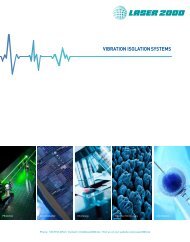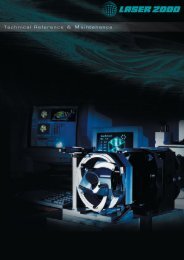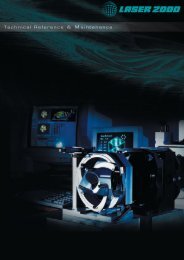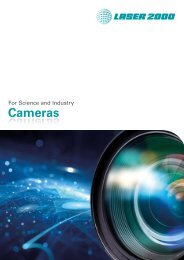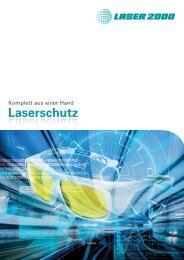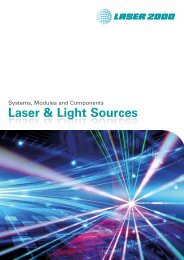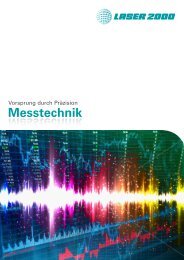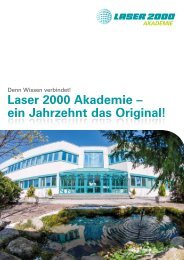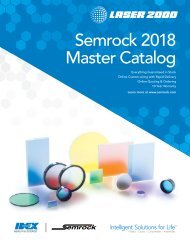Filters
Filters
Filters
You also want an ePaper? Increase the reach of your titles
YUMPU automatically turns print PDFs into web optimized ePapers that Google loves.
Cold <strong>Filters</strong><br />
CLDF<br />
Catalog<br />
Code<br />
W3115<br />
Application<br />
Systems<br />
Optics &<br />
Optical<br />
Coatings<br />
Opto-<br />
Mechanics<br />
Bases<br />
Manual<br />
Stages<br />
Actuators &<br />
Adjusters<br />
Motoeized<br />
Stages<br />
The principle of the cold filter is similar to the glass that is used in a halogen lamp to protect the<br />
heat. It enables the visible range to transmit and cut-off the IR range (heat).<br />
◦The feature of the dielectric optical coating filter is to have a steep decline of transmittance from the visible range to IR<br />
range. In addition to this; the heat absorption filter is efficient for transmitting at the visible range and cutting off the IR range.<br />
◦It is frequently used as a IR cut filter on a CCD sensor.<br />
◦It is also used as a filter to cut-off the heat from the illumination in a biological microscope to avoid heating up the specimen.<br />
Specifications<br />
Material<br />
Heat-absorbing glass<br />
Incident angle 0°<br />
Wavelength Range<br />
400 − 2000nm (Cut off more than 900nm)<br />
Surface Quality (Scratch−Dig) 60−40<br />
Clear aperture<br />
90% of external dimension of the square<br />
inscription circle<br />
Guide<br />
▶Different size, wavelength and deviation ratio that are not mentioned<br />
on-line or in our catalog are available as custom products<br />
upon on request.<br />
▶For a specific filter holder, please contact our Sales Division.<br />
Light Sources &<br />
Laser Safety<br />
Index<br />
Guide<br />
Schematic<br />
Front surface:<br />
Dielectric multi-layer coating<br />
Rear surface: Uncoated<br />
Attention<br />
▶The transmittance graph drops on the long side of the visible range<br />
when the incident angle is slightly slanting.<br />
▶When placing the filter too close to a light source, the heat<br />
absorption may damage the filter due to a rapid change of the temperature.<br />
▶The backside of the cold filter is not coated with AR. The absorption<br />
filter may have a backside reflectance value of 4%, a total of<br />
20% of loss can occurred.<br />
Mirrors<br />
Beamsplitters<br />
Polarizers<br />
Lenses<br />
Multi-Element Optics<br />
Outline Drawing<br />
(in mm)<br />
<strong>Filters</strong><br />
50±0.3<br />
Prisms<br />
Substrates/Windows<br />
Optical Data<br />
Maintenance<br />
Selection Guide<br />
ND <strong>Filters</strong><br />
Diffusers<br />
Colored Glass<br />
<strong>Filters</strong><br />
Dielectric <strong>Filters</strong><br />
Etalon<br />
Specifications<br />
Part Number<br />
50±0.3 2±0.1<br />
High transmittance range<br />
(normal incident)<br />
[nm]<br />
Transmittance<br />
(normal incident)<br />
[%]<br />
Cutoff range<br />
(normal incident)<br />
[nm]<br />
100<br />
80<br />
Transmittance of<br />
cutoff range<br />
(normal incident)<br />
[%]<br />
Typical Transmittance Data<br />
Wavelength at 50%<br />
[nm]<br />
CLDF-50S 400 − 600 >80 800 − 2000



